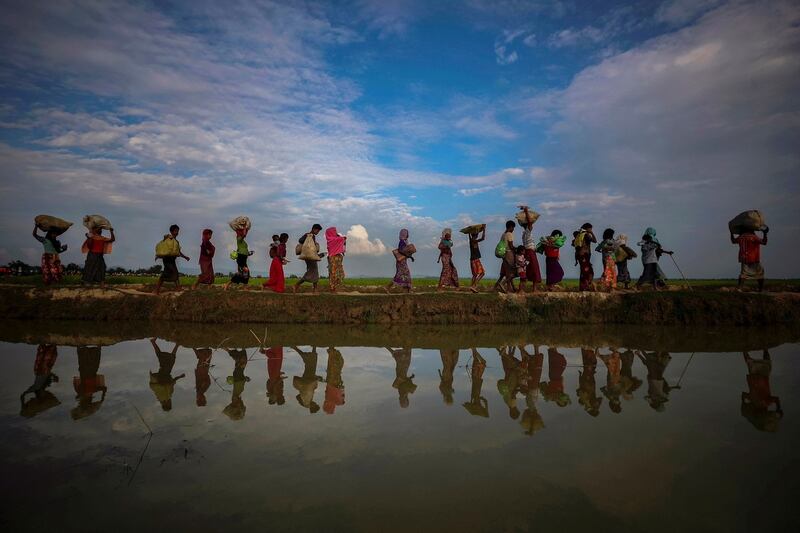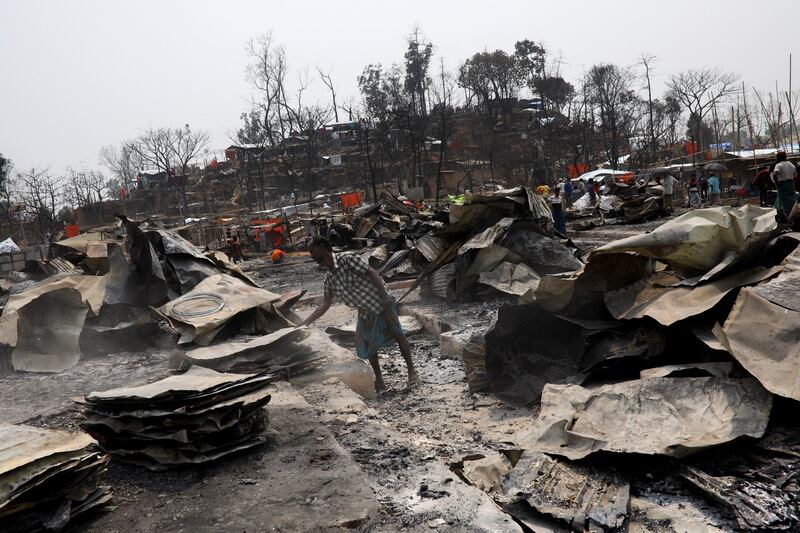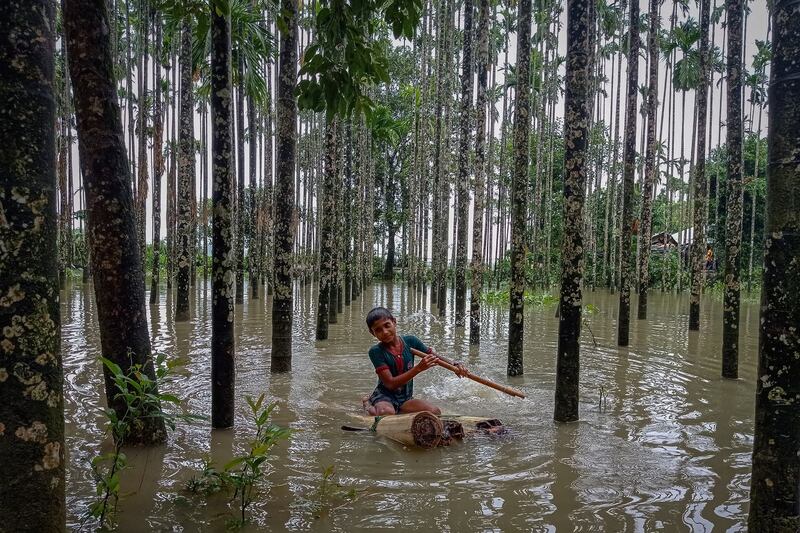At least eight Rohingya children drowned in the Bay of Bengal last week – casualties of a desperate people’s desire to get away from the Bangladeshi camps where they’ve been confined since fleeing Myanmar four years ago.
They were among three dozen souls aboard a small boat that capsized in bad weather on Aug. 14 off Bhashan Char Island, leaving 26 dead or missing, and providing a bleak reminder of the plight of one million Rohingya who languish in refugee camps in Bangladesh. Three-quarters of them fled a 2017 Myanmar military crackdown, whose grim anniversary falls on Wednesday.
Bashir Ahmad was one of 12 people rescued by local fishermen from the capsized boat. He and ten family members had risked their lives to get away from the remote camp on Bhashan Char, where nearly 19,000 Rohingya have been shifted since December, with the promise of better conditions than in the sprawling camps of Cox’s Bazar in southeastern Bangladesh.
"My wife and my four children are still missing,” Bashir told BenarNews. “We came here [Bhashan Char] with the hope for a better life, but we were deprived of it.”
Authorities have given up the search for the survivors.
The boat deaths in the Bay of Bengal came ahead of what Syed Ullah, leader of the Arakan Rohingya Society for Peace and Human Rights, calls “a black day for Rohingya people.”

Rohingya refugees walk along an embankment next to paddy fields after fleeing from Myanmar into Palang Khali, near Cox's Bazar, Bangladesh Nov. 2, 2017. (Reuters)
A life of fleeing
Aug. 25, 2017 was when a wave of attacks by poorly equipped Rohingya militants on Myanmar police posts in western Rakhine State, which borders Bangladesh, set off a bloody Myanmar military onslaught against Rohingya communities.
The crackdown displaced 740,000 people, and according to humanitarian organizations, thousands were killed. U.N. investigators have accused Myanmar's military of carrying out mass killings and rapes with "genocidal intent".
The Rohingya still say they want to return to their homes in Myanmar. But the prospects for their repatriation, and of fulfilling their desire for Myanmar citizenship, appear as slim as ever.
Complicating the situation is the military coup that was launched in Myanmar nearly seven months ago that has installed a junta and stoked bloodshed and further conflict across the country.
The hopelessness of their situation pushes Rohingya to keep trying their chances for life elsewhere, despite the peril of an uncertain sea voyage to make it happen.
Rashida Begum, 35, says she was meant to be on the boat that sank Aug. 14. “I skipped the journey due to my younger son’s sudden illness,” Rashida, a mother of three, told BenarNews over the weekend. “I don’t know when our life of fleeing will end.”
Rashida’s story is emblematic of the struggles of the Rohingya, a stateless people. She has spent most of her adult life in limbo.
She first fled her home in Maungdaw district of Rakhine State some 16 years ago after the Myanmar military allegedly killed one of her family members, and settled in Cox’s Bazar.
Then in February 2020, she said, she left on a boat that drifted at sea for two months, unable to enter Thailand, Malaysia or even Myanmar. Bangladesh coastguards rescued the boat and sent them back to the same Cox’s Bazar camp. Three months later she was arrested by Bangladeshi police as she tried to find work outside the camp.
Later, she moved to the camp at Bhashan Char from Cox’s Bazar, seeking better health and education for her children, but was disappointed – as many of the others who have made the same choice have been.
When senior officials from the refugee agency UNHCR visited the island in late May, a violent protest broke out among hundreds of refugees who complained about living conditions and being unable to earn any money, among other grievances.
“Now I am trying to flee from here,” Rashida said.
“People always try to stay in their birthplace and come up with dreams about their place. But it is a nightmare for our Rohingya people,” Rashida said. “I am on the run just for a better and a safe life.”

A Rohingya refugee stands among the remains after a fire broke out and destroyed thousands of shelters at the Balukhali refugee camp in Cox's Bazar, Bangladesh, March 24, 2021. (Reuters)
Dreaming of home
She’s not alone. Last week, UNHCR reported that 2020 was the deadliest year on record for refugee journeys in the Bay of Bengal and the Andaman Sea. The COVID-19 pandemic prompted many Southeast Asian countries to tighten their borders, leading to the highest numbers of refugees stranded at sea since the region’s “boat crisis” in 2015, UNHCR said, referring to a year when tens of thousands attempted to flee Myanmar and Bangladesh by sea.
It said some two-thirds of those attempting those voyages were women and children.
“These deadly journeys are not a new phenomenon,” the UNHCR report said. “The roots of these dangerous journeys are found in Myanmar, where the Rohingya were stripped of their citizenship and denied basic rights.”
Meanwhile, critics say Bangladesh remains opposed to international efforts to improve living standards for Rohingya in the camps because it could lead to a growing interest of the Rohingya in settling permanently rather than seeking to return to their villages in Myanmar.
Diplomacy between Bangladesh and Myanmar to pave the way for their return appears to be going nowhere. Shah Rezwan Hayat, Bangladesh’s refugee relief and repatriation commissioner, said talks about repatriation had stalled because of upheaval in Myanmar and the COVID-19 situation.
But Rohingya refugees were still interested in going back to Myanmar, he said.
Refugees at Cox’s Bazar attest to that.
“We are still dreaming of going back home. Nobody can enjoy the life of a refugee, as well as the humiliation,” said Mustafa Kamal, a Rohingya who recounts how he twice fled to Bangladesh: in 2012, when there was an earlier wave of violence against minority Muslims in Myanmar, and during the 2017 crackdown.
Another camp resident, Nur Ahmed, said that he fled in 2017 after the soldiers set fire to his three-story home in Rakhine State.
“Refugee life is not a life at all. We are spending every moment here with various fears. We want to go back to our homeland with citizenship,” he said.
Refugees are not allowed to work in Bangladesh, and police on Monday arrested 74 Rohingya who were working as day laborers in lemon orchards near the southern city of Chittagong. A police officer told BenarNews they would be prosecuted, along with those who helped them.
Over the past two months, at least 600 Rohingya have been arrested in various parts of Bangladesh and sent back to the refugee camps, officials said.

A child crosses a flooded area in a makeshift raft at Maulovir Para, Cox's Bazar, on July 30, 2021, after monsoon floods and landslides cut off villages across southeast Bangladesh and killed at least 20 people, including six Rohingya refugees. (AFP)
